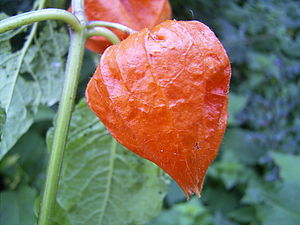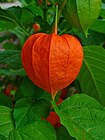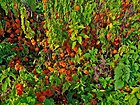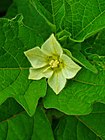Note: This is a project under development. The articles on this wiki are just being initiated and broadly incomplete. You can Help creating new pages.
Physalis alkekengi - Bladder cherry
Physalis alkekengi (bladder cherry, Chinese lantern, Japanese-lantern, strawberry groundcherry, or winter cherry) is a relative of P. peruviana (Cape gooseberry). It is easily identifiable by the large, bright orange to red papery covering over its fruit, which resembles paper lanterns.
Uses
abortion, gravel, malaise, malaria, skin inflammations, kidney, bladder disorders, Common Cold, gout.
Parts Used
Chemical Composition
Like a number of other species in the genus Physalis, it contains a wide variety of physalins. When isolated from the plant, these have antibacterial and leishmanicidal activities in vitro.It also contains caffeic acid ethyl ester, dehydro-physalin L, physalin D, and cuneataside E[1]
Common names
| Language | Common name |
|---|---|
| Kannada | |
| Hindi | Akarkara |
| Malayalam | Akkarakaaram |
| Tamil | |
| Telugu | |
| Marathi | NA |
| Gujarathi | NA |
| Punjabi | NA |
| Kashmiri | NA |
| Sanskrit | Akarkarabh |
| English | Pellitory |
Properties
Reference: Dravya - Substance, Rasa - Taste, Guna - Qualities, Veerya - Potency, Vipaka - Post-digesion effect, Karma - Pharmacological activity, Prabhava - Therepeutics.
Dravya
Rasa
Guna
Veerya
Vipaka
Karma
Prabhava
Habit
Identification
Leaf
| Kind | Shape | Feature |
|---|---|---|
| Smooth | Alternate, Pinnate | Alternate or opposite, stalked. Leaf blade widely ovate, usually blunt-based, with entire margins–sparsely large-toothed, sparsely short-haired |
Flower
| Type | Size | Color and composition | Stamen | More information |
|---|---|---|---|---|
| Unisexual | 15–20 mm (0.6–0.8 in.) wide | yellowish white | Stamens 5 | Regular (actinomorphic), fused, wheel-shaped, 5-lobed, underside hairy. Calyx fused, 5-lobed, initially campanulate, green; spreading, concealing berries after flowering, eventually 25–50 mm (1–2 in.) long, oval, yellowish red, anthers tight against corolla tube |
Fruit
| Type | Size | Mass | Appearance | Seeds | More information |
|---|---|---|---|---|---|
| spherical | 15 mm (0.6 in.) long berry | Fruiting time: July–August | seeds many, ovoid. | {{{6}}} |
Other features
List of Ayurvedic medicine in which the herb is used
- Vishatinduka Taila as root juice extract
Where to get the saplings
Mode of Propagation
How to plant/cultivate
Seed - sow March/April in a greenhouse only just covering the seed. Germination usually takes place quickly and freely. [3]
Commonly seen growing in areas
Photo Gallery
References
- ↑ "Chemical constituents"
- ↑ "Plant Description"
- ↑ Cite error: Invalid
<ref>tag; no text was provided for refs namedCultivation details
External Links
- Pages with reference errors
- Ayurvedic Herbs known to be helpful to treat abortion
- Ayurvedic Herbs known to be helpful to treat gravel
- Ayurvedic Herbs known to be helpful to treat malaise
- Ayurvedic Herbs known to be helpful to treat malaria
- Ayurvedic Herbs known to be helpful to treat skin inflammations
- Ayurvedic Herbs known to be helpful to treat kidney
- Ayurvedic Herbs known to be helpful to treat bladder disorders
- Ayurvedic Herbs known to be helpful to treat Common Cold
- Ayurvedic Herbs known to be helpful to treat gout
- Herbs with Roots used in medicine
- Herbs with Leaves used in medicine
- Herbs with Fruits used in medicine
- Herbs with common name in Hindi
- Herbs with common name in Malayalam
- Herbs with common name in Sanskrit
- Herbs with common name in English
- Habit - Perennial herb
- Index of Plants which can be propagated by Seeds
- Index of Plants which can be propagated by Cuttings
- Herbs that are commonly seen in the region of wasteland
- Herbs that are commonly seen in the region of gardens
- Herbs that are commonly seen in the region of Ornamental
- Herbs
- Solanaceae







